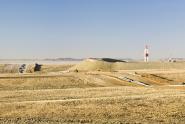Digging into Shale Exploration

Natural gas holds the keys until green energy glimmers. With the potential to now access deposits once thought unattainable, producers are getting increasingly pumped.
While coal will continue to maintain its market share for power generation, natural gas is expected to gain more and more ground. That's because it emits about half of the greenhouse gases that some say are responsible for global warming. To that end, the abundance of shale gas - a type of natural gas -- is central to the mission.
"With the shale plays, the utility folks who invest in power generation will put more of their money into plants that burn natural gas," says Mike John, president of Northeast Natural Energy that is exploring the Marcellus region throughout Appalachia. "Over the last 10-15 years, our industry has advanced technologically and we have refined the process, which has allowed us to `crack the code.'"
Like the other shale deposits such as those in the Barnett and Haynesville regions, John says that the Marcellus formation is "repeatable." That means the wells keep producing, translating into lower break even points when compared with the exploration of traditional natural gas. Such dynamics would tend to keep supplies stable and ensure that prices don't sink.
Natural gas prices are low relative to the historical highs largely because of a national recession that has helped curb energy demand. It is also because of greater-than-usual production and high levels of storage.
In recent times, natural gas prices have hovered around $4 per million BTUs, says the U.S. Energy Information Administration. Two years ago, they were almost $8 for the same unit. John, whose office is in Charleston, WV, says that traditional producers need prices to be at $6 per million BTUs for it to work, although shale developers can profit at lower prices because their well sites are "repeatable."
Shale producers, generally speaking, are upbeat about their prospects. Consider that the Energy Information Administration in its 2010 annual outlook pegs "technically recoverable" natural gas resources in the United States at 2,119 trillion cubic feet. Of that, it says that 347 trillion cubic feet is shale, albeit it falls under "unproved technically recoverable" deposits. Those numbers are similar to ones published by the Colorado School of Mines Potential Gas Committee.
"Shale gas production remains strong," says John Curtis, professor at the Colorado School of Mines and author of a productivity report sponsored by the Potential Gas Committee. "It is continuing to rise because of the large volumes being recovered as well as the access to markets and pipelines."
Water Quality
To be sure, shale gas production faces some difficult opposition. That's because some communities have complained that the drilling process harms water quality. The shale gas, which is deeply embedded in the rocks, must be coaxed out through the injection of chemicals - a process known as hydraulic fracturing, or fracking.
Now the U.S. Environmental Protection Agency is stepping in and asking shale producers to voluntarily reveal what chemicals they are using to unearth the gas. Those producers, which were granted an exemption from doing just that under the previous administration, have argued that the information is proprietary. They have also said there is no proof that their processes are to blame for tainted water supplies.
The Obama administration, which sees natural gas as a bridge until its green era takes root, says that fracking has become so divisive that producers realize that they have to quell the concerns. "Natural gas is an important part of our nation's energy future, and it's critical that the extraction of this valuable natural resource does not come at the expense of safe water and healthy communities," says EPA Administrator Sheila Jackson.
Producers understand that the issue must be resolved if their enterprises are to succeed. Mike John of Northeast Natural Energy says that the footprint left by today's drilling rigs is much smaller than those in the past. For example, they can now drill vertically several thousand feet below the earth's surface before going horizontally for more than a mile.
That technique, known as horizontal drilling, allows producers to place 8-to-10 "long-reach lateral wells" in one small area, he says. That compares to prior methods that required as many as 16 vertical wells over about 640 acres.
The most common problems with fracking occur when the drilling is at shallow levels of 1,000 feet or less. While coal-bed methane is discovered at such depths, shale is much further down at 8,000 feet. That makes it extremely difficult for shale producers to chemically taint the surface water supplies, John says.
The industry, generally, spends considerable time and resources testing "rock cores" to ensure that there are no insipid infections, all while it routinely monitors injection pressures. Such operations are done in real-time, allowing companies to cease the job if they see anything untoward.
"We can drill enough wells from one spot and that improves the surface impact of what we do," says John. "That negates some of the opposition. About half the cost of a drilling job can be attributed to assuring that the fracking process is safe."
Market fundamentals favor natural gas and shale. But the drilling processes associated with shale have become controversial. Producers are trying to allay the fears by cooperating with regulators, pointing out that such resources can also provide carbon-friendly power to utilities while helping to meet the nation's energy demands.
So what do you think? Please share your thoughts by posting a quick comment below, or by sending a longer reply to energybizinsider@energycentral.com.
EnergyBiz Insider is nominated for Best Online Column by Media Industry News
Copyright © 1996-2010 by CyberTech, Inc. All rights reserved.
To subscribe or visit go to: http://www.energybiz.com